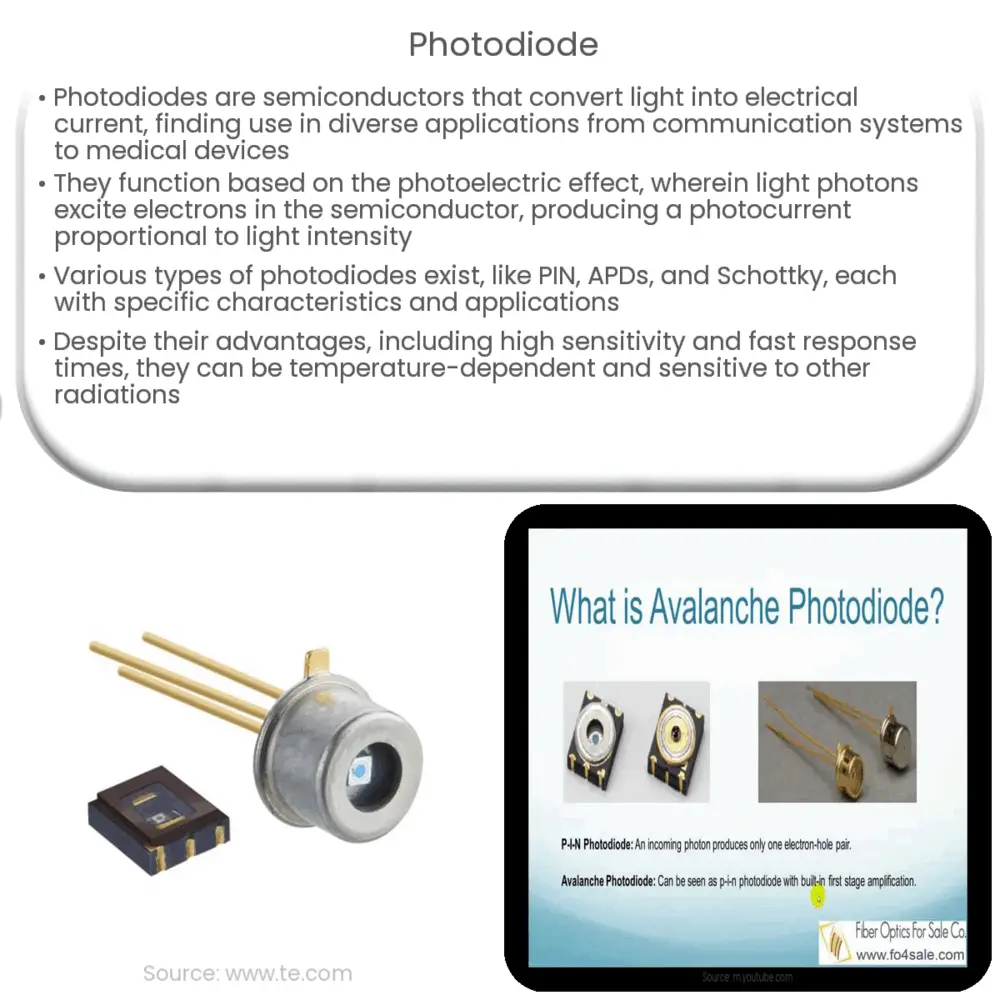A photodiode is a semiconductor device that converts light into electrical current, with applications in communication, sensing, and renewable energy.

Understanding Photodiodes: The Basics and Applications
Introduction to Photodiodes
A photodiode is a semiconductor device that converts light into an electrical current. This unique property allows photodiodes to be used in various applications ranging from simple light detection to more complex communication systems. In this article, we will discuss the basics of photodiodes, their working principles, and some of their practical applications.
Working Principle of Photodiodes
Photodiodes are made from semiconductor materials such as silicon, germanium, or gallium arsenide. These materials exhibit a property called the photoelectric effect, which is the foundation of a photodiode’s functionality. When photons (light particles) strike the surface of the semiconductor, they transfer their energy to the electrons in the material. This energy causes the electrons to be excited and break free from their atoms, creating electron-hole pairs.
Under normal conditions, these electron-hole pairs would recombine, and no current would flow. However, when a reverse-biased voltage is applied across the photodiode’s terminals, the electric field created by the voltage separates the electron-hole pairs, causing them to flow in opposite directions. The electrons flow towards the anode, while the holes flow towards the cathode. This flow of charge carriers creates a photocurrent, which is proportional to the intensity of the incident light. Thus, the photodiode converts light energy into electrical energy.
Types of Photodiodes
There are several types of photodiodes, each with its unique characteristics and applications. Some common types of photodiodes include:
- PIN Photodiodes: These photodiodes have an intrinsic (undoped) semiconductor layer sandwiched between a p-type and an n-type layer. The intrinsic layer increases the depletion region width, providing a larger area for photon absorption and improving the photodiode’s response time and sensitivity.
- APDs (Avalanche Photodiodes): APDs are designed to operate at higher reverse-biased voltages, near the breakdown voltage. This causes a phenomenon called the avalanche effect, where electron-hole pairs generate more carriers through impact ionization, resulting in a significantly amplified photocurrent. This increased sensitivity makes APDs suitable for low-light applications.
- Schottky Photodiodes: These photodiodes are formed by creating a junction between a metal and a semiconductor. Schottky photodiodes are known for their fast response times and low capacitance, making them ideal for high-speed applications.
Applications of Photodiodes
Photodiodes have a wide range of applications in various industries, including:
- Optical Communication: Photodiodes are used as receivers in fiber-optic communication systems, where they convert the light signals transmitted through the optical fiber into electrical signals that can be processed by electronic devices.
- Light Detection and Measurement: Photodiodes can be used to measure light intensity and detect the presence or absence of light in various applications, such as ambient light sensors, optical encoders, and photometers.
- Medical Devices: In medical equipment, photodiodes are used for optical sensing, such as pulse oximeters, which measure oxygen saturation in the blood by analyzing the absorption of light by hemoglobin.
Consumer Electronics
Photodiodes are widely used in consumer electronics for various applications, such as:
- Remote Controls: Infrared photodiodes are used in remote controls to detect the infrared signals emitted by the remote control, allowing the device to respond to the user’s commands.
- Camera Light Meters: Photodiodes are used in cameras as light meters to measure the light intensity and adjust the camera settings accordingly for optimal exposure.
- Optical Mouse: Optical mice use photodiodes to track movement by detecting changes in the light reflected from the surface the mouse is operating on.
Solar Cells
Photovoltaic cells, also known as solar cells, are a type of photodiode designed to convert sunlight into electrical energy. These cells are made from semiconductor materials such as silicon and are widely used in solar panels to generate electricity for residential, commercial, and industrial applications.
Smoke Detectors
Photodiodes are used in some smoke detectors to detect the presence of smoke particles. When smoke enters the detection chamber, it scatters the light, which then falls on the photodiode, causing a change in photocurrent. This change in current is analyzed by the detector’s electronics, which triggers an alarm if the smoke concentration exceeds a predetermined threshold.
Advantages and Disadvantages of Photodiodes
Photodiodes offer several advantages, including:
- High sensitivity to light
- Fast response times
- Low power consumption
- Excellent linearity between light intensity and photocurrent
- Wide dynamic range
However, photodiodes also have some disadvantages, such as:
- Temperature dependence of photocurrent, which may require temperature compensation in some applications
- Sensitivity to other types of radiation, like X-rays or gamma rays, which may cause unwanted signals or noise
- Dark current (leakage current) that flows even in the absence of light, leading to increased noise levels
Conclusion
Photodiodes are versatile semiconductor devices that offer a wide range of applications in various industries, including communication systems, consumer electronics, medical devices, and renewable energy. Their ability to convert light into electrical signals makes them a critical component in many modern technologies. By understanding the working principles, types, and applications of photodiodes, engineers and scientists can continue to develop innovative solutions and improve existing technologies that rely on these devices.

